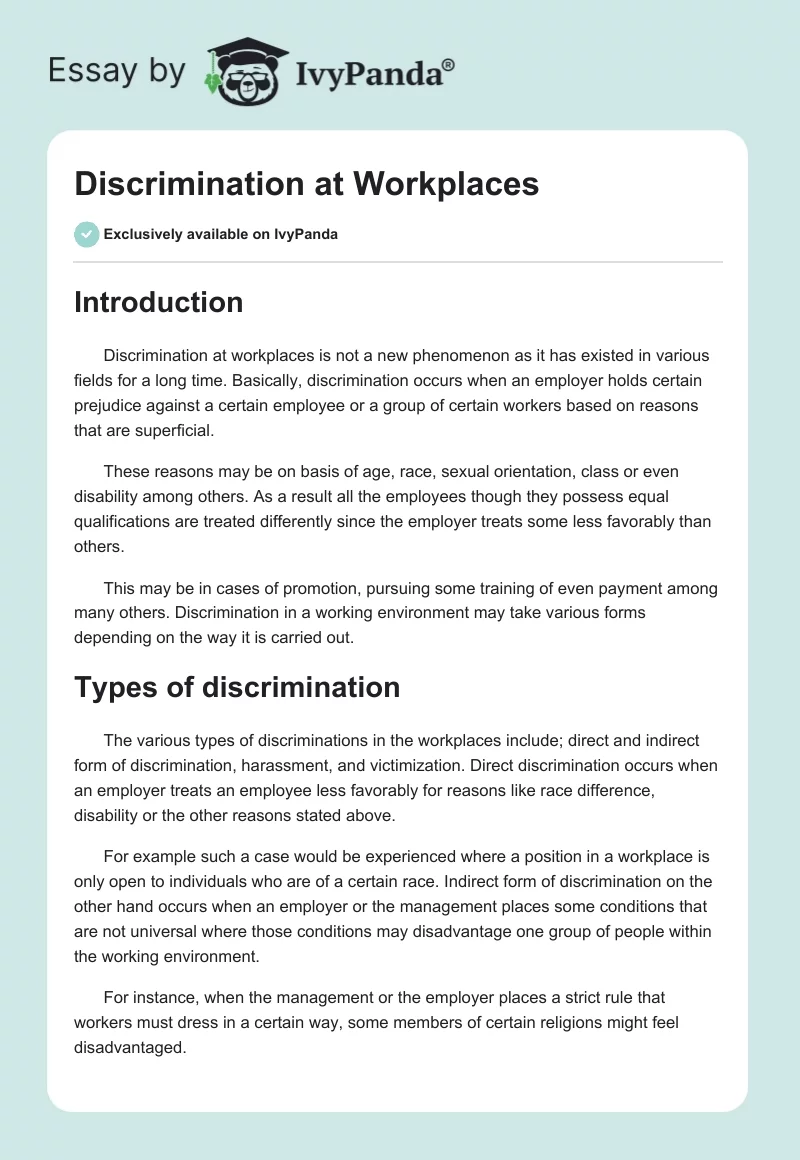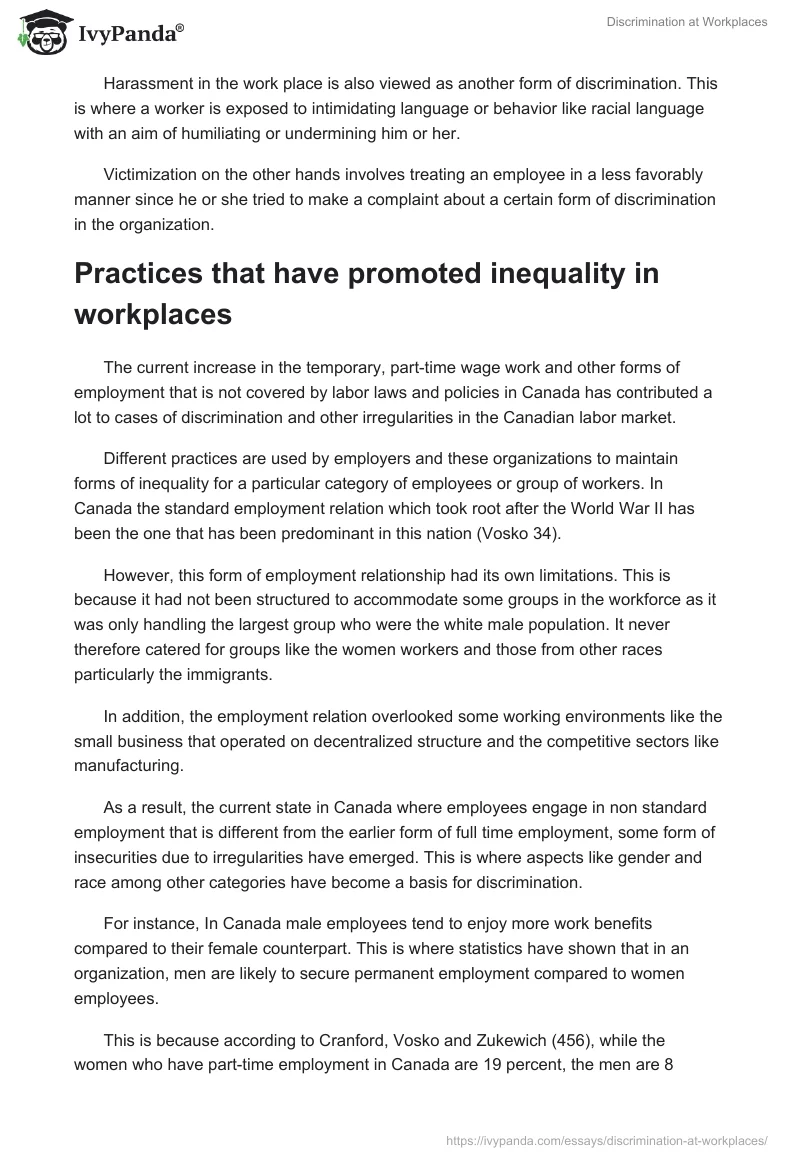Introduction
Discrimination at workplaces is not a new phenomenon as it has existed in various fields for a long time. Basically, discrimination occurs when an employer holds certain prejudice against a certain employee or a group of certain workers based on reasons that are superficial.
These reasons may be on basis of age, race, sexual orientation, class or even disability among others. As a result all the employees though they possess equal qualifications are treated differently since the employer treats some less favorably than others.
This may be in cases of promotion, pursuing some training of even payment among many others. Discrimination in a working environment may take various forms depending on the way it is carried out.
Types of discrimination
The various types of discriminations in the workplaces include; direct and indirect form of discrimination, harassment, and victimization. Direct discrimination occurs when an employer treats an employee less favorably for reasons like race difference, disability or the other reasons stated above.
For example such a case would be experienced where a position in a workplace is only open to individuals who are of a certain race. Indirect form of discrimination on the other hand occurs when an employer or the management places some conditions that are not universal where those conditions may disadvantage one group of people within the working environment.
For instance, when the management or the employer places a strict rule that workers must dress in a certain way, some members of certain religions might feel disadvantaged.
Harassment in the work place is also viewed as another form of discrimination. This is where a worker is exposed to intimidating language or behavior like racial language with an aim of humiliating or undermining him or her.
Victimization on the other hands involves treating an employee in a less favorably manner since he or she tried to make a complaint about a certain form of discrimination in the organization.
Practices that have promoted inequality in workplaces
The current increase in the temporary, part-time wage work and other forms of employment that is not covered by labor laws and policies in Canada has contributed a lot to cases of discrimination and other irregularities in the Canadian labor market.
Different practices are used by employers and these organizations to maintain forms of inequality for a particular category of employees or group of workers. In Canada the standard employment relation which took root after the World War II has been the one that has been predominant in this nation (Vosko 34).
However, this form of employment relationship had its own limitations. This is because it had not been structured to accommodate some groups in the workforce as it was only handling the largest group who were the white male population. It never therefore catered for groups like the women workers and those from other races particularly the immigrants.
In addition, the employment relation overlooked some working environments like the small business that operated on decentralized structure and the competitive sectors like manufacturing.
As a result, the current state in Canada where employees engage in non standard employment that is different from the earlier form of full time employment, some form of insecurities due to irregularities have emerged. This is where aspects like gender and race among other categories have become a basis for discrimination.
For instance, In Canada male employees tend to enjoy more work benefits compared to their female counterpart. This is where statistics have shown that in an organization, men are likely to secure permanent employment compared to women employees.
This is because according to Cranford, Vosko and Zukewich (456), while the women who have part-time employment in Canada are 19 percent, the men are 8 percent. Just like sex, race is a predominant determiner of the employee’s access to permanent employment.
For instance, in Canada white men are likely to get permanent employment compared to men of color. When comparing both men and women of color, women of color are less likely to get permanent employment compared to their male counterparts.
Age is also a factor in access to permanent employment in Canadian labor market. This is where young people are less likely to get full-time permanent employment when compared to those who are middle-aged or older individuals.
All these factors have contributed to insecurity in the Canadian labor market as they have disadvantaged several groups of individuals through giving more privileges to others.
The government of Canada or the Canadian labor market has not placed any labor prohibitions on any gender regarding their participation in the labor market. However, the cultural and political values in this nation have consistently empowered a system where there are differences in the access and even in the participation of certain members in the labor market.
This is where, for instance, males dominate some forms of employment while women are found in particular areas of employment. This is clearly seen in the health provision areas where most medical doctors who are highly paid are male.
On the other hand, the nurses who are mostly female are less paid as their job is viewed to be of lower status. Although employment chances for women have increased substantially, there are more non-standard work arrangements makings which are increasing the chances of discriminations in the workplaces.
This is in areas of payments and access to promotion chances. On the other hand, there have been cases of loss of jobs for the ageing and the unqualified population.
There are other forms that have been used to perpetuate inequality in the labor market in Canada. The modernization in organizations has led to changes in the individuals’ quality of working life. This is where the increasing intellectualization in various work functions has resulted to permanent changes.
In work relationships, there has been inequality between those who have acquired the knowledge in modern technology making them appear more qualified and able to deal with new challenges as opposed to those who hold moderate training; who area seen as dependent on routine training and those who depend on order to carry out their tasks.
The various work-related inequalities that have been manifested by differences in payments among workers, promotion chances, employment security and even the level of social integration within the work environment require appropriate measures to mitigate them. There are various strategies that can be applied to encourage equalities in the various workplaces.
Strategies of advancing equalities in the workplaces
Since in most working environments, the employer has more power and authority over the employee as he or she has the right to terminate an employee’s contract and immediately get a replacement, workers can combine forces to increase their bargaining power.
Collective bargaining is therefore one of the most efficient tools of advancing equality in the workplaces. It refers to a process where employees of an organization present their grievances to their employer through their representatives.
This often happen in organizations where the employees have formed a union through which they are able to negotiate for better working conditions collectively. This strategy has proved to be the most effective as the employer will seek to avoid any decision that may lead to work stoppage since this may lead to incurring of losses.
Though collective bargaining through unionization has been used in the past as a tool for negotiating salaries and wages increase, it can also be used to address the issue of work inequalities. For instance, in Canada, organization members have used unions to handle various aspects of inequality in their organizations.
This has led to reducing the wage gap between various categories of workers in contract provisions (Duffy, Daniel and Pupo 46). This is through encouraging initiatives like pay and employment equity among the members of the union. Union also negotiates for non-monetary inequalities in the work places.
These include improvement of working conditions for particular members in the organization with an aim of ensuring their safety within the working environment.
The union often comes up with collective agreement together with their employer which clearly stipulates how disputes are to be resolved in the organization. It also lays the rights that the employee is entitled to in the organization.
Social movements have also been other methods that the workers in Canada have used to advance equality in workplaces. This is where people who share similar goals come together to campaign against their discrimination in various areas of society and workplaces.
This has been common among the minority groups within a certain environment. For instance, the gay and lesbians have been victims of discrimination in various work environments.
To these groups social movements have been very effective in addressing various forms of discriminations that they go through (Adams 86). Their main goal is to achieve social equality through right to enjoy their freedom, and protection from harm among other benefits.
Passing of employment equity act is another strategy to achieving work-related equality. This is an initiative of the Labor Program that outlines various measures that are aimed at eliminating inequality in workplaces.
According to Human Resources and Skills Development Canada (para 14), the Racism-Free Workplace Strategy (RFWS) is one of their commitment which aims at promoting fair and equitable workplaces.
This is through elimination of barriers that have in the past prevented promotion of minorities like the Aboriginal people in various workplaces. The labor program achieves this through establishment of partnership with employers, unions and even non-governmental organizations.
This has been effective in advancing equality since it involves increasing awareness of the benefits of eliminating discrimination in work environments through creation of racism-free environments.
Conclusion
Increase in inequality has been noted in the recent past where it has emerged in new forms that were initially not there. This has made it the most common economic and social issue in the current work environment. Due to individuals who suffer this vice remaining silent, some of the negative consequences that discrimination causes have been overlooked making them progress and cause more damage.
However, the new Canadian labor laws if well implemented can assist in advancing social and economic equality in various workplaces. This is because the laws promote the actions of various organizations’ unions and promote the rights of all members in the nation.
Works Cited
Adams, J. Roy. “Prospects for labour’s right to bargain collectively after BC health services.” UNB Law Journal 59 (2009): 85-94. Print.
Cranford, Cynthia, Vosko Leah F. and Nancy Zukewich. “The gender of precarious employment in Canada.” Industrial Relations, 58.3 (Fall. 2003): 454-462.
Duffy, Ann, Glenday Daniel and Pupo Norene. The shifting landscape of work. Toronto: Nelson Education, 2011. Print.
Human Resources and Skills Development Canada. Employment Equity Act: Annual Report 2009. Canada, Labour. 2010. Web.
Vosko, F. Leah. Gender differentiation and the standard/non-standard employment distinction in Canada: 1945 to the present. Toronto: University of Toronto Press, 2003. Print.


